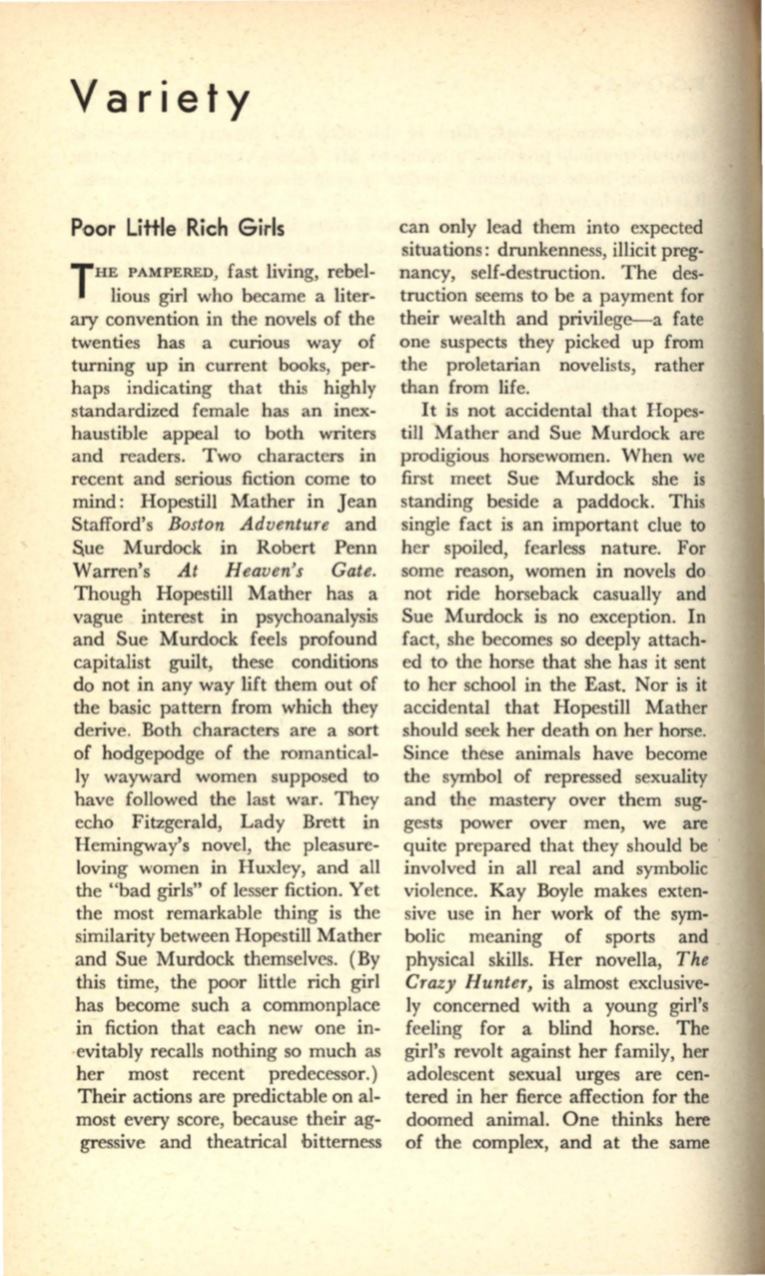
Variety
Poor Little Rich Girls
T
HE PAMPERED,
fast living, rebel–
lious girl who became a liter–
ary convention in the novels of the
twenties has a curious way of
turning up
in
current books, per–
haps indicating that this highly
standardized female has an inex–
haustible appeal to both writers
and readers. Two characters in
recent and serious fiction come to
mind: Hopestill Mather in Jean
Stafford's
Boston Adventure
and
Sue Murdock in Robert Penn
Warren's
At Heaven's Gate.
Though Hopestill Mather has a
vague interest in psychoanalysis
and Sue Murdock feels profound
capitalist guilt, these conditions
do not in any way lift them out of
the basic pattern from which they
derive. Both characters are a sort
of hodgepodge of the romantical–
ly wayward women supposed to
have followed the last war. They
echo Fitzgerald, Lady Brett in
Hemingway's novel, the pleasure–
loving women in Huxley, and all
the "bad girls" of lesser fiction. Yet
the most remarkable thing is the
similarity between Hopestill Mather
and Sue Murdock themselves. (By
this time, the poor little rich girl
has become such a commonplace
in fiction that each new one in–
evitably recalls nothing so much as
her most recent predecessor.)
Their actions are predictable on al–
most every score, because their ag–
gressive and theatrical bitterness
can only lead them into expected
situations: drunkenness, illicit preg–
nancy, self-destruction. The des–
truction seems to be a payment for
their wealth and privilege-a fate
one suspects they picked up from
the proletarian novelists, rather
than from life.
It is not accidental that Hopes–
till Mather and Sue Murdock are
prodigious horsewomen. When we
first meet Sue Murdock she is
standing beside a paddock. This
single fact is an important clue to
her spoiled, fearless nature. For
some reason, women in novels do
not ride horseback casually and
Sue Murdock is no exception. In
fact, she becomes so deeply attach–
ed to the horse that she has it sent
to her school in the East. Nor is it
accidental that Hopestill Mather
should seek her death on her horse.
Since these animals have become
the symbol of repressed sexuality
and the mastery over them sug–
gests power over men, we are
quite prepared that they should be
involved in all real and symbolic
violence. Kay Boyle makes exten–
sive use in her work of the sym–
bolic meaning of sports and
physical skills. Her novella,
The
Crazy Hunter,
is almost exclusive–
ly concerned with a young girl's
feeling for a blind horse. The
girl's revolt against her family, her
adolescent sexual urges are cen–
tered in her fierce affection for the
doomed animal. One thinks here
of the complex, and at the same


